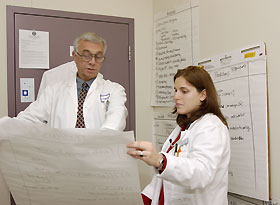For more archives, go to the Advance Archive/Search Page.
Primary Care Physician Continues
Traditions at Health Center
 |
Dr. Anthony Voytovich and Elizabeth Schiller, a third-year medical student, look over flip charts listing patient symptoms. Voytovich, a longtime faculty member at the medical school, takes pride in treating students as colleagues. |
Anthony Voytovich M.D. arrived at the UConn School of Medicine in 1974 from Case Western Reserve University School of Medicine. He thought he’d be around for a year or two, build his resume, then move on to be department chair or dean at another medical school.
He never left.
At the school, he found something he didn’t expect. He calls it “UConn magic,” and it’s a combination of things: the small size of the school; the deeply committed faculty; well-motivated and well-rounded students; and an educational experience, in his opinion, quite unlike anywhere else.
“There’s a sense of community and togetherness that no other medical school has,” Voytovich says.
In his various positions over the years as chief of general medicine, chief of staff of John Dempsey Hospital, dean of students in the medical school, and teacher, Voytovich’s interactions with students and faculty, patients and staff have been positive and personal.
“I treat students as colleagues,” he says, “I believe in that, and I’ve learned as much from them as they’ve learned from me.”
The Case Western-UConn medical school from which Voytovich came has had a long-standing connection with the Health Center. Among the Case Western faculty who came to Farmington were Irwin Lepow, chief of medicine, and T. Joseph Sheehan, community medicine; they recruited Voytovich to join the Department of Medicine and concentrate on primary care.
He was well suited to it. His main mentor was a Case Western physician, Dr. Thomas Hale Ham, an internationally known researcher and specialist in medical education. Ham devised the Case Western curriculum – a student-centered curriculum that focused on organ systems – that the Health Center took as a model.
His motto was “The student is a colleague” – an aphorism Voytovich took to heart.
During his residency at Cleveland Metro General Hospital, Case Western’s teaching hospital, Voytovich found the most impressive physician care-givers were the community-based internists who referred patients to the hospital, the primary care doctors.
“Their ability, skill, and knowledge of their patients was unparalleled,” he says.
As he concentrated on internal medicine and primary care, he began to reflect on why physicians make certain clinical judgments.
Internists routinely see patients with multiple problems, he says. A patient with chronic arthritis might also complain of heartburn, be a little depressed or unable to sleep well, and have impaired sexual function.
Treating that person may depend on accommodating 50 or 60 different pieces of information in a consistent, regular way, day after day, month after month. Sooner or later, diagnostic thinking breaks down.
“I became fascinated with the way people screwed up when dealing with a multi-dimensional problem,” he says. “I studied and researched the limitations of human information processing as it related to a challenging diagnosis.”
Multi-problem patients are what a doctor encounters in primary care, he says. A patient might report eight or 10 different problems.
“That’s what makes primary care so exciting,” he says. “Specialists might be experts in yellow, or experts in blue. In primary care, you’ve got to be an expert in green.”
Cultivating that appreciation in students became the work of a lifetime, but it was work he enjoyed, helping transform smart, eager students into skilled and caring physicians.
Voytovich says that task was shared by the entire faculty – medical educators like Lepow, Dr. Eugene Sigman, who became dean of the medical school, and Dr. Achilles Pappano.
“There were a lot of people like that here,” he says. “The institution had that culture and it laid the foundation early on.”
But Voytovich assigns standout credit for the school’s special flavor to the late professor of ethics and his personal friend, James “Jay” Healey.
“Jay Healey established the standards of ethical and professional behavior,” Voytovich says. “He helped us to know what’s right and what’s not.
“I consider him a kind of priest, a holy person, who taught us much, as other prophets and leaders have taught us,” he adds. “Such people are keepers of myth and ritual. They are central to their observance.”
Those rituals, Voytovich says, add much to the medical school’s rare climate, and many still exist. One is the Coating Ceremony, where first-year students come forward to receive their first white coat from second-year students. During the ritual, the dean of students says something warm and personal about them that the students didn’t know he knew.
Voytovich’s influence is clear from the recollections of his former students.
“He was one of the initial people who showed me that you can blend academics with clinical work and be good at it,” says Winston Campbell, M.D. ’77, now professor of obstetrics and gynecology and holder of the Physicians Health Services Chair in Maternal-Fetal Medicine. “Dr. Voytovich had a detailed approach to patient management and assessment. He taught me good bedside manners and he was a great role model.”
Dr. Anthony “Bud” Ardolino, M.D. ’80, associate dean, was so influenced by Voytovich that he followed directly in his footsteps. Like Voytovich, he too is an internist. When Ardolino was a student, Voytovich ran the Introduction to Medicine class. Ardolino’s first job as an academic was chair of that class.
“He influenced me in more ways than you could believe,” Ardolino says. “I am an internist because of him. He was the exact model of a practitioner that I wanted to be.”

